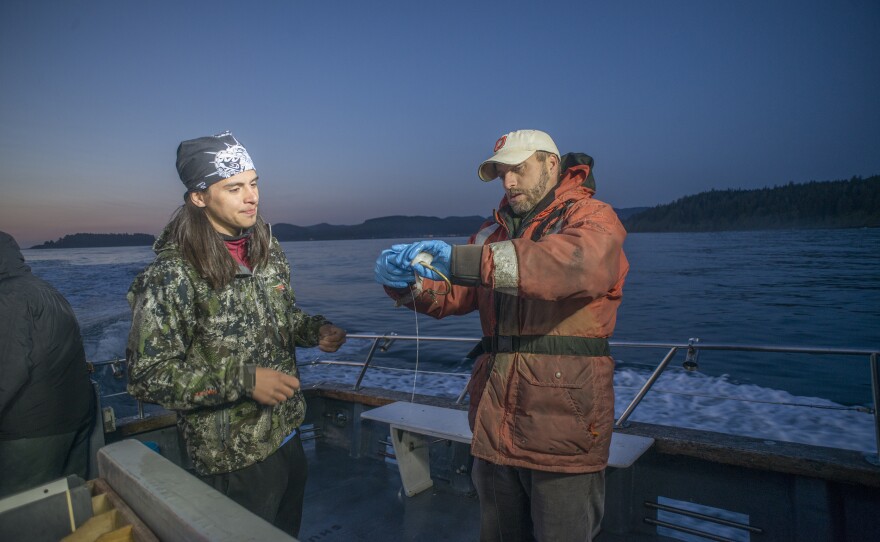As the sun rose above Neah Bay one foggy morning three years ago, a boatful of anglers headed out to the Pacific Ocean to fish for halibut — something their Makah ancestors have done for thousands of years.
“We got 30 minutes to catch as much fish as possible,” Rosina Depoe of Neah Bay said. “We all dropped our hooks at the same time, and as soon as we felt the fish bite, we'd reel it up, and we’d get it on the boat as quickly as possible.”
The fishing trip wasn't for fun or food. It was for science.
The anglers were volunteers in an experiment. They were testing whether an ancient Makah technology could tackle a modern-day problem: how to harvest food from the ocean without harming endangered species.
The trip helped prove that sometimes old technology succeeds where the latest gadgetry fails.
“Each of us had our own fishing rod, and each rod was alternating a circle hook or a čibu·d [chih-bood],” Depoe said, using the Makah language’s term for a traditional halibut hook.
A circle hook is the preferred modern gadget for reeling in big fish like halibut.
And this is a čibu·d:
[asset-images[{"caption": "", "fid": "144288", "style": "placed_left", "uri": "public://201804/HalibutHookSwanIllusOnly.JPG", "attribution": "Credit James Swan, “Indians of Cape Flattery,” 1870, Smithsonian Institution"}]]“Cibu·d is the historical, traditional version of a halibut hook,” Depoe said. “It's how we fished halibut before modernization.”
The Makah language illustrates a long history of living off the ocean. Food and fish are the same word: ha-oob.
“There’s words in Makah that describe jigging or trolling for fish, or using a spreader bar for halibut,” said Maria Pascua with the Makah Cultural and Research Center in Neah Bay. “There’s words for setting net on the river, or beach net, or ocean-side. It’s very specific.”
Even now, food from the sea remains central to survival and culture on the Makah Reservation, at the Olympic Peninsula's remote northwest corner, known to the Makah as "the beginning of the world." The average income there is less than $16,000 a year — about half the national average.
With no major salmon rivers in their territory, the Makah have traditionally relied on halibut more than any other fish, unlike many salmon-centric Northwest tribes.
Anthropologists a century ago observed Makah fishing crews coming back from sea with just halibut in their canoes.
That brings us to one other name among the Makah for the čibu·d: In a newspaper article in 1905, a Makah fisherman named Henry Markishtum called the hook “the curved genius.”
“This hook was known for specifically just getting halibut, not anything else, so it limited bycatch,” Depoe said.
Bycatch refers to hauling up the wrong type of fish — a big problem with modern fishing. Those unwanted fish often wind up dead, even if they're thrown back into the sea.
Much of the ocean off the Washington coast is off-limits to halibut fishing because of the toll it takes on another species — yelloweye rockfish.
Rockfish can live a century or more. Washington state counts 13 kinds of rockfish as “species of concern,” and two of them — yelloweye and bocaccio — are protected under the federal Endangered Species Act.
“This really pretty fish here, this is a yelloweye rockfish,” Makah Tribe biologist Jonathan Scordino told an audience at the Salish Sea Ecosystem Conference in Seattle in April. "They don’t start reproducing until they’re about 40.”
(So, yes, they could star in an underwater remake of The 40-Year Old Virgin.)
Rockfishes' slow reproduction makes them especially susceptible to overfishing, which is where the čibu·d comes in.
[asset-images[{"caption": "Makah elder Jesse "Hushta" Ides with a finished cibud hook", "fid": "144289", "style": "placed_wide", "uri": "public://201804/1jesse_with_finished_hook.jpg", "attribution": "Credit Debbie Preston"}]]Originally, čibu·d hooks were made by steaming a piece of hemlock or yew, bending it into a big, curvy U and lashing a sharp piece of bone onto it. But the Makah adopted newer materials when they became available.
“When the U.S. government gave them pitchforks to work their land, they knocked off the tines and made them into fishhooks,” Scordino said to laughter at the science conference.
Volunteers from the Makah community helped Scordino hand-craft a bunch of čibu·d out of brass. Then they tested them out at sea.
“We found that this hook was extremely selective for halibut," Scordino said. "Ninety-one percent of the fish hooked were halibut."
The old-school hooks were much more selective than their modern counterparts. The circle hooks often brought up the wrong fish; nearly half of the fish they caught weren’t halibut.
The čibu·d only snagged three rockfish, while the modern hooks caught more than a hundred. On the downside, the čibu·d didn’t catch as many halibut, either.
Scordino attributes some of that to inexperience. It's possible that some of the čibu·d, all made by hand by volunteers, weren’t shaped right. And the anglers were also inexperienced at using the historical hooks.
Now Scordino wants to improve the manufacturing of the čibu·d and test out other materials. He thinks the ancient čibu·d could let the Makah resume halibut fishing in rockfish-protection areas that have been off-limits for the past 20 years.
Rosina Depoe said the čibu·d study reinforces her belief that tribal traditions can help solve modern problems.
“It made me feel proud to see that we had innovations before people, before settlers even had it,” she said.




